|
|
Post by smithy on Mar 12, 2018 21:01:49 GMT 12
@rnzsunday: A book about NZ airmen & women "Fearless" is the first full history of their efforts in WWI. Historian Adam Claasen of @masseyuni at 10.05 t.co/8Kl2P3mIMbOnly just stumbled across this and have duly purchased. Many thanks for the heads up, although I don't think my bank account is too thrilled this is the third WWI aviation title I have bought this month! |
|
|
|
Post by Dave Homewood on Mar 23, 2018 22:10:35 GMT 12
This comes from the WANGANUI HERALD, 1 JULY 1920
PERILOUS ADVENTURES.
ON SEA AND IN THE AIR SENSATIONAL EXPERIENCES OF A WANGANUI LAD.
SAVED BY MARVELOUS BRITISH MEDICAL SKILL.
One of the last New Zealanders to return from service abroad is Flight-Lieutenant S. B. Inman, son of Mrs H Inman, of Wanganui, who arrived by the Arawa a fortnight ago, after experiencing some thrilling adventures on land and sea, for the last of which he has been under treatment in an English hospital for two years.
The young officer served his apprenticeship with Messrs Allen Bros., the well-known local firm of engineers, and left Wanganui for England in 1915 to join up with the British Mercantile Marine. He was transferred to the Navy, in which he saw service for twelve months (1916-17), afterwards joining the Royal Naval Air Service, with which organisation he was connected when he met with a thrilling and dreadful accident, which incapacitated him for so long a period.
While in the Navy Flight-Lieutenant Inman served on H.M.S. Ponus (a torpedo oiler) and later on H.M.S. Princetown, an auxiliary cruiser of 11,000 tons, formerly the German vessel Prinz Albert, of the Hamburg-American Line, which took shelter in Falmouth (England) in 1914, and was subsequently claimed by the British Crown. It was while on the Ponus that the lad had his FIRST SENSATIONAL EXPERIENCE, the vessel being burned off the coast of Falmouth in 1916, after running on a reef during a terrific gale. The whole of the officers and crew managed to get ashore in lifeboats, though clad only in their pyjamas. The ill-fated vessel, which was laden with 11,000 tons of oil for the Admiralty, burned for four days and four nights, the vivid and remarkable scene being witnessed by many thousands.
From the Princetown the young naval recruit was transferred to H.M.S. Wabasha, a vessel of 11,000 tons, and he had not been very long on her when he experienced his SECOND SENSATIONAL ADVENTURE. While being escorted from the Scilly Islands to Devonport by H.M.S. Antrim (a fine 24,000-ton cruiser of the county class), the Wabasha was torpedoed amidships by a German submarine, which, the Antrim subsequently captured or destroyed. Fortunately the Wabasha was not sunk, though great holes were torn in her bottom and sides by the terrific force of the explosion. With several feet of water in the engine-room, a heavy list, and all available pumps working, the vessel was skilfully navigated to Devonport, after eight hours' strenuous and anxious work, and put on the floating dry dock for repairs. When the torpedo struck the Wabasha two deck officers were blown through the decks, and a gunner and a gun-layer were also killed and a number injured.
In May of 1917 our young hero looked for adventure elsewhere, and joined the Royal Naval Air Service, qualifying for his pilot's certificate at Greenwich College, London. His first work in the air was PATROLLING THE CHANNEL off the Yorkshire coast, escorting food ships, and engaged in the interesting pastime of strafing German submarines there, subsequently going to Calshot, on Southampton water.
On one occasion the young pilot took part in an engagement with a squad of German Fokkers, which had crossed the Channel and were making their way over Kent when intercepted by the Manston patrol, which brought one of them to earth, others falling to aircraft guns ere they were able to escape.
It was while at Manston that Flight-Lieutenant Inman met with a most THRILLING AND DREADFUL ACCIDENT. He had been in the Air Service for about twelve months and was testing a light bombing aeroplane (DH9), when at a height of 500 feet engine trouble developed and the machine was enveloped in flames. The situation was desperate, and with the flames surging all around him he maintained his hold of the wheel and side-slipped the burning machine to mother earth, effecting what, under the circumstances, was a remarkable landing on the aerodrome at the edge of the cliffs.
His clothes, which included a naval uniform and flying overalls, were nearly all burned off his body, as was also his flying helmet, and in dreadful suffering and torture he rolled in the grass to subdue the flames, which had burned deeply into his face, arms, legs, and body, leaving great ugly wounds. Assistance was immediately forthcoming, and in a condition more dead than alive (though he retained full consciousness until placed in an ambulance) he was taken to the Queen’s Hospital, where all that British medical skill and science could command was placed at his disposal. For some considerable period Iris life was despaired of, the great suffering ho had to endure, combined with the shock to the system, causing the gravest anxiety.
Patient and skilful nursing and medical skill triumphed in the end, and on the 2nd May, 1920 — exactly two years to the day after he entered the institution — he was discharged. During that period he underwent no less than 18 OPERATIONS, his sufferings in connection with which can but faintly be realised, certainly not described. Skin-grafting was amongst the most delicate of the numerous operations performed, Britain’s most skilled facial experts being engaged. Present and past pupils and teachers of the Wanganui Collegiate School will be more than interested to hear that foremost amongst these was Major H. Gillies (an old boy of the College), who completed his studies in England, and has recently visited America to demonstrate the marvellous strides which have been made in England in the science of skin-grafting, cartilage, and facial work.
The injured officer was also attended by Major Russell (an Australian doctor) and Captain Ruamsey (a Cambridge student), all R.A.M.C. facial experts. They performed wonders for their patient, whom they provided, amongst other marvellous feats, with a new nose and eyebrow. Though grievously scarred by the dreadful burns, Flight-Lieutenant Inman is a striking testimony to the MARVELS OP BRITISH MEDICAL SCIENCE, which he descants on most enthusiastically. He speaks of the most wonderful operations which came under his own personal observation while in hospital. He has seen a soldier, who had his chin blown clean away, fitted with a new jaw.
|
|
|
|
Post by Dave Homewood on Mar 23, 2018 22:12:30 GMT 12
I find the above article fascinating, I never realised Fokkers ventured over to Kent (I am assuming they were fighters?), and it's really interesting to hear he was based at Manston, the famous Battle of Britain station. Plus the story of his burns being treated and the New Zealander involved is also really reminiscent of the Battle of Britain/WWII story of Archibald McIndoe.
|
|
|
|
Post by Dave Homewood on May 6, 2018 23:10:57 GMT 12
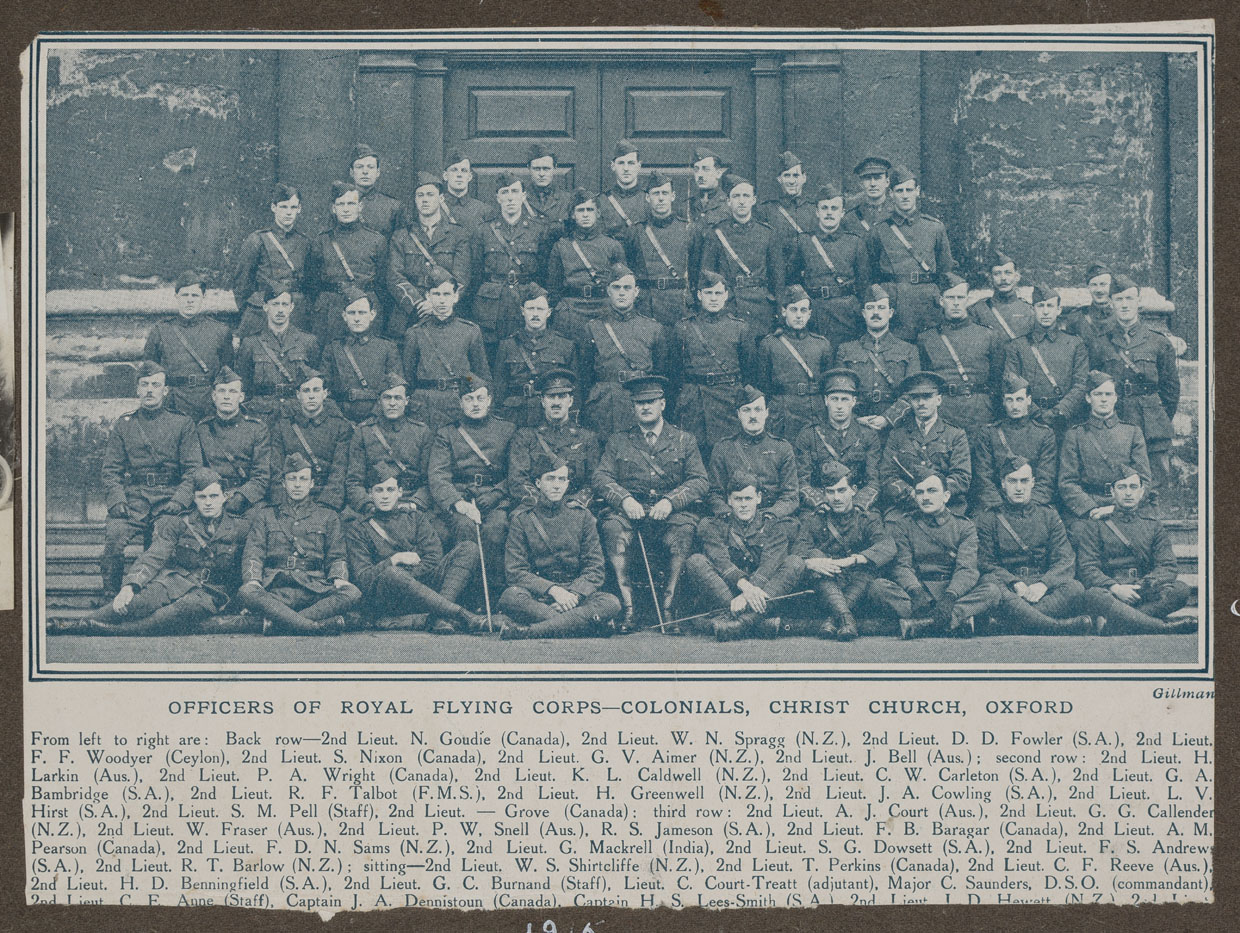 There is a number of New Zealand pilots in this group photo from HERE |
|
|
|
Post by Dave Homewood on Jun 13, 2019 20:42:28 GMT 12
Two more New Zealand airmen I just came across not mentioned on this page yet are: Captain N.P. Dixon RAF, AFC, of Christchurch Lieutenant Commander F.W. Bowhill, mid Both come from this list, but I do not see a service record for either in the National Archive's site |
|
|
|
Post by errolmartyn on Jun 13, 2019 21:50:20 GMT 12
Two more New Zealand airmen I just came across not mentioned on this page yet are: Captain N.P. Dixon RAF, AFC, of Christchurch Lieutenant Commander F.W. Bowhill, mid Both come from this list, but I do not see a service record for either in the National Archive's site Noel Parker Dixon was born at Leeston. He continued to serve with the RAF during the interwar years and right through until 1945. You can remove Bowhill's name. He was not a New Zealander and has no connection with the country. The suggestion that he did is due to an error made in a High Commissioner's listing in WWI. Errol |
|
|
|
Post by Dave Homewood on Jun 13, 2019 21:53:29 GMT 12
Thanks Errol.
|
|
|
|
Post by Dave Homewood on May 10, 2020 16:25:51 GMT 12
Today I have heard from Dave Williamson who's father was WWI pilot and WWII RNZAF member Charles Williamson. Dave has kindly sent through the following photos and information. 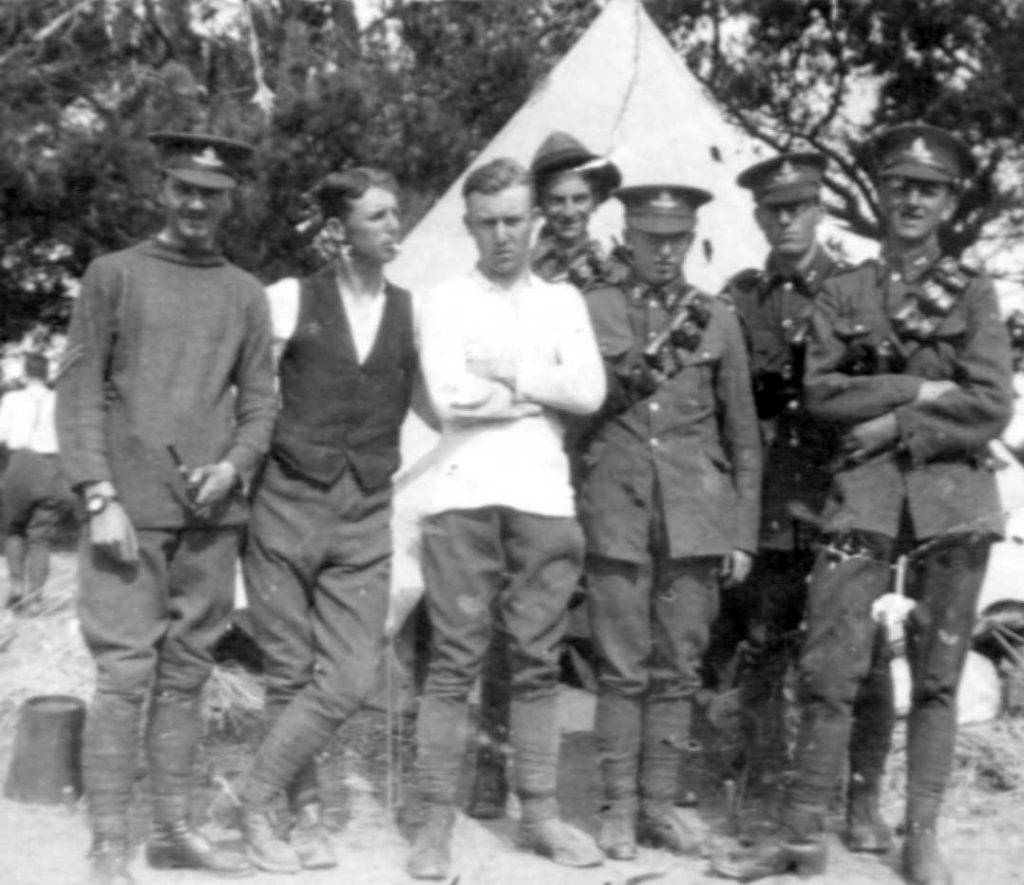 Dave says, "My dad was in the RFC in 1917/8 , he went to the UK on the "Ruahine" and spent 4 months there doing coastal patrols, then came back to NZ. The one called Charles in white shows my dad just before they were shipped over to England in Jan 1918." 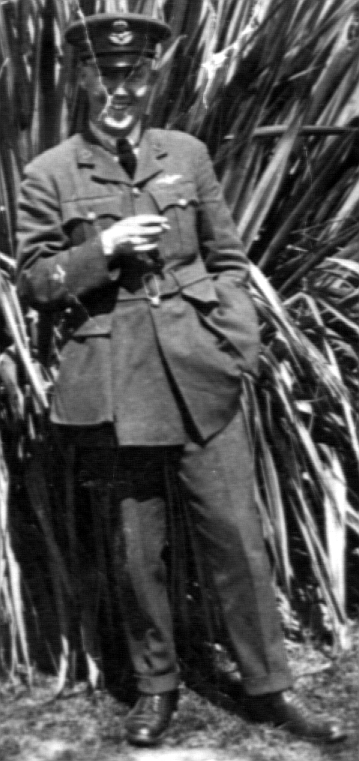 Charles Robert Williamson  Dave says, "Charles R. Williamson talking to the aircraft engineer, standing next to a Caudron G3 training aircraft at Sockburn." "Scans of very old press cuttings." 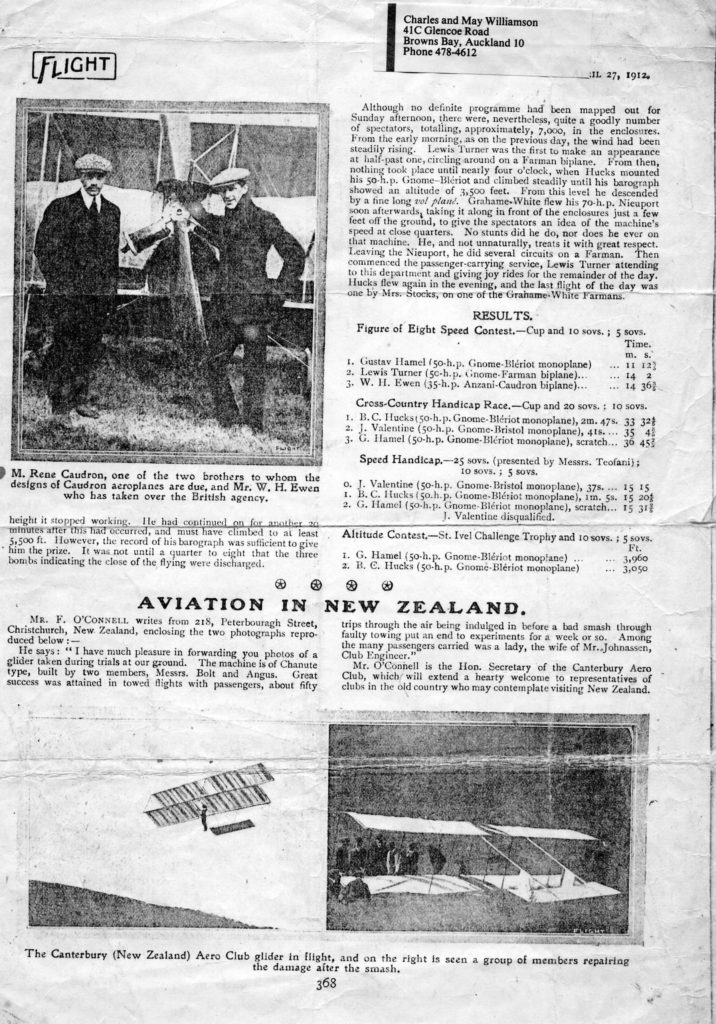   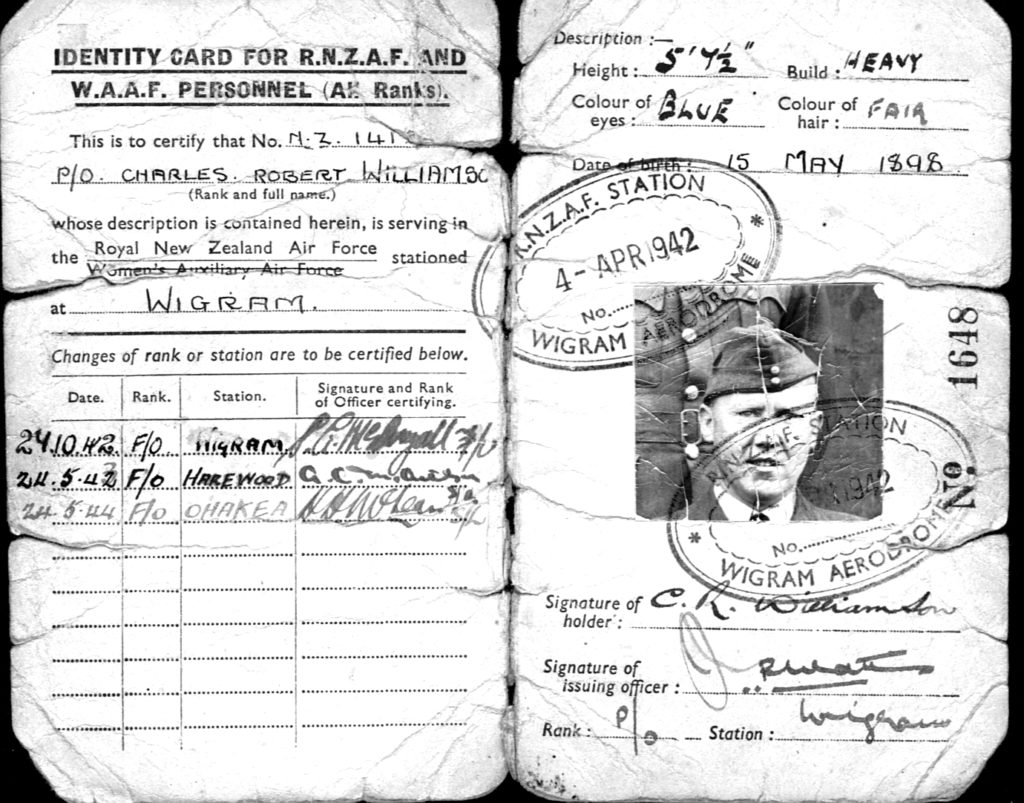 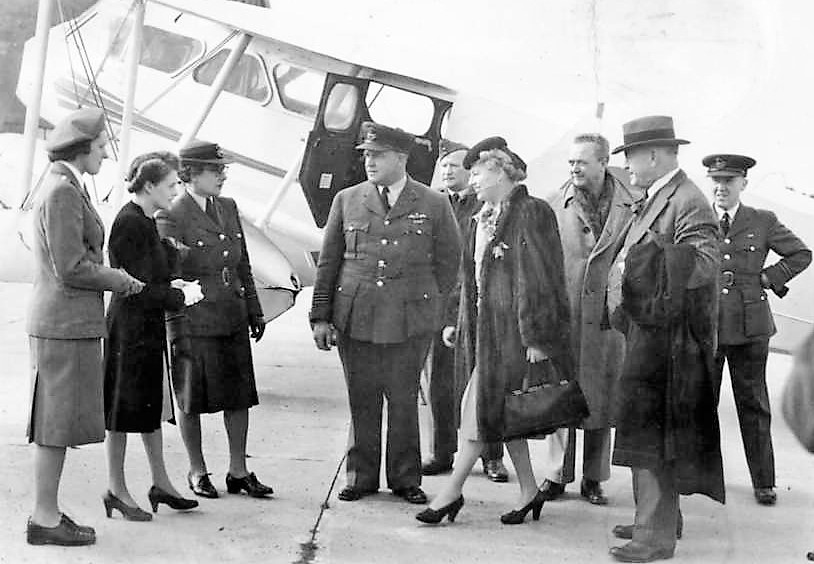 Dave says, "I recall being told that Dad was involved in organising the flights for Gracie Fields around NZ... Gracie Fields after she has just got off the plane at Ohakea and it was taken approx. August 1945 . My dad is on the right hand side in the photo. 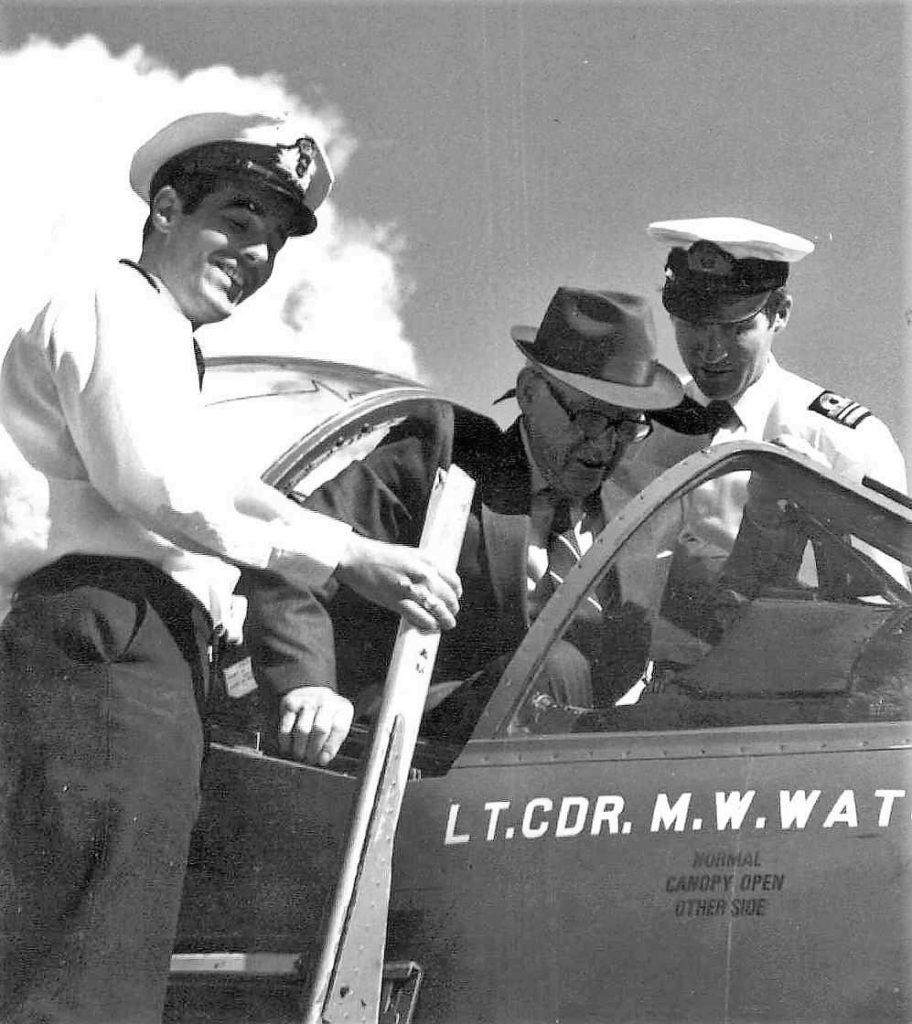 Dave says, "Re photo of dad getting into the Harrier was taken, the title self- explains it. The photo was taken ... I think... in the mid 1980's at Whenuapai during a visit of a UK aircraft carrier I believe." 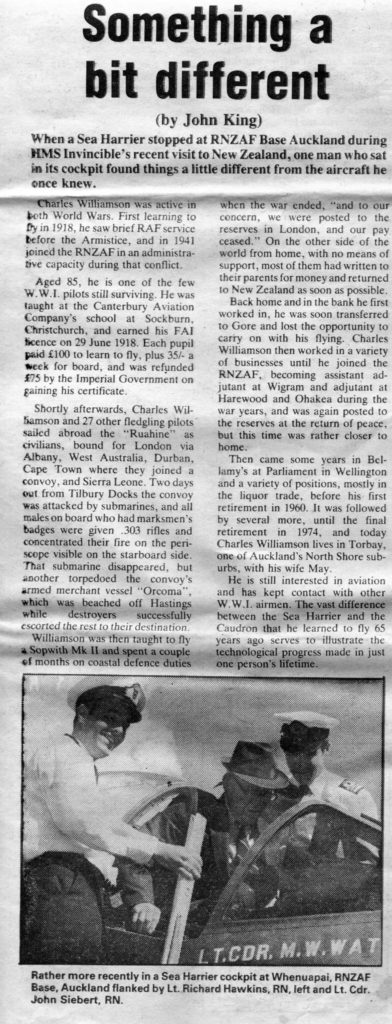 "Full story about Dad's Whenuapai/Harrier visit....from a 1984 newspaper." |
|
|
|
Post by errolmartyn on May 12, 2020 22:38:36 GMT 12
Today I have heard from Dave Williamson who's father was WWI pilot and WWII RNZAF member Charles Williamson. Dave has kindly sent through the following photos and information.  Dave says, "My dad was in the RFC in 1917/8 , he went to the UK on the "Ruahine" and spent 4 months there doing coastal patrols, then came back to NZ. The one called Charles in white shows my dad just before they were shipped over to England in Jan 1918."  Charles Robert Williamson  Dave says, "Charles R. Williamson talking to the aircraft engineer, standing next to a Caudron G3 training aircraft at Sockburn." "Scans of very old press cuttings."      Dave says, "I recall being told that Dad was involved in organising the flights for Gracie Fields around NZ... Gracie Fields after she has just got off the plane at Ohakea and it was taken approx. August 1945 . My dad is on the right hand side in the photo.  Dave says, "Re photo of dad getting into the Harrier was taken, the title self- explains it. The photo was taken ... I think... in the mid 1980's at Whenuapai during a visit of a UK aircraft carrier I believe."  "Full story about Dad's Whenuapai/Harrier visit....from a 1984 newspaper." History here has become rather mixed up over time, I fear. Charles Robert Williamson sailed for the UK on the Ruahine on 17 August 18 and disembarked in London on 30 October. As the Armistice was signed less than a fortnight later he received no training in the UK and was on his way back to New Zealand on the Matatua on 8 January 1919, disembarking in Wellington on 21 February. He was thus never a member of the RFC and certainly flew no coastal patrols. That’s a very nice photograph of a Canterbury (NZ) Aviation Company Caudron (not a G3, by the way). The ‘engineer’ referred to is CAC’s Grant Mackie. Cheers, Errol |
|
|
|
Post by drumcar7988 on Jun 29, 2020 11:27:50 GMT 12
I'm quite puzzled, as my father spoke about flying a Sopworth - though only for a few days- along the southeast coastal vicinity, out from Kent, where he was billeted.
Also, I have his his RFC badge !?!?!?!? !
|
|
|
|
Post by errolmartyn on Jun 29, 2020 11:33:27 GMT 12
I'm quite puzzled, as my father spoke about flying a Sopworth - though only for a few days- along the southeast coastal vicinity, out from Kent, where he was billeted. Also, I have his his RFC badge !?!?!?!? ! The aircraft would have been a Sopwith, not a Sopworth. The company manufactured a number of different WWI aircraft. What was the name of your father? Errol |
|
|
|
Post by drumcar7988 on Jul 2, 2020 14:31:33 GMT 12
Hi Errol: His name was: Charles Robert Williamson
|
|
flymac
Pilot Officer

Posts: 45 
|
Post by flymac on Dec 7, 2021 20:14:42 GMT 12
I have enjoyed the photos above on this forum. This small half frame photo was found by a family member in a family Bible. It was in damaged condition. It features my Grandfather Lt. William Leonard Harrison of 65 Squadron. The photo on the rear names the two airman - L.A.M Armstrong, Will, L.A.M Huntley. I believe the photo was on a camera my Grandfather never travelled without. Of interest is that the Sopwith Camel B2408 is the very aircraft my Grandfather was shot down in over German lines and he became a POW. So we can date this photo before 6/11/1917 as that was the date he was shot down in this aircraft.  |
|
|
|
Post by Dave Homewood on Mar 9, 2022 22:15:39 GMT 12
This would have been a very interesting event to attend with my digital recorder and camera!
FIRST WAR AIRMEN
Reunion Held At Auckland
(N.Z. Press Association)
AUCKLAND, March 25.
Sixty-five veteran airmen, whose ages ranged up to 82, attended the annual meeting and reunion of the New Zealand (1914-18) Airmen’s Association in Auckland at the week-end. One of the oldest, 79-year-old Major de Bath Brandon, of Wellington, the only New Zealander known to have shot down a Zeppelin, was elected vice-president. At a dinner on Saturday night the toast to the association was proposed by the president of the Auckland R.S.A., Mr E. J. Waters. The president-elect, Mr A. R Kingsford, of Nelson, replied. The toast to the R.N.Z.A.F. was proposed by Air Chief Marshal Sir Keith Park and replied to by Air Vice Marshal M. F. Calder, Chief of the Air Staff. There was a roll call of members and their old squadrons.
The retiring president, Mr K. Caldwell, of Auckland, laid a wreath during a service conducted at the Cenotaph this morning by Chaplain Flight Lieutenant R. Robertson, of Whenuapai. Afterwards members visited the Auckland Museum to inspect the Spitfire and Zero exhibits and hear talks about them.
The committee elected at the annual meeting later, and who will organise the reunion in Wellington next year, are Messrs W. Butterfield, I. Keith, A. D. Morris, and C. H. Leese (all of Wellington), Mr R. B. Bannerman (Gore), and Mr C. Gillies (Oamaru).
PRESS, 26 MARCH 1962
|
|
|
|
Post by Dave Homewood on Mar 10, 2022 21:38:32 GMT 12
Veteran Airmen Talk Of Sorties—Among Selves
Talk of air battles and sorties over France in World War I, and of the types of aircraft in use then is expected to occupy elderly men from Auckland to Invercargill gathered in Christchurch for the fifth annual reunion of the New Zealand 1914-1918 Airmens’ Association.
Last evening the 40 or 50 men enjoyed an informal get-together. According to the association’s vice-president (Mr R. B. Bannerman) delegates include many former representatives of the Royal Flying Corps, the Royal Naval Air Service, and the Royal Air Force which officially came into being as such on April 1, 1918. Mr Bannerman shot down 17 enemy aircraft in World War I.
Among those who arrived early in the evening were two of the first five pilots to graduate from Wigram— Messrs C. J. McFadden and E A F Wilding. A personality well known in military aviation circles, Air Commodore Keith “Grid” Caldwell, was warmly welcomed by old comrades. “Grid” Caldwell was one of the first two pilots to graduate from the flying-boat base at Kohimarama. Happy to chat among themselves about their wartime exploits none was inclined to do so publicly.
“None of these fellows will talk about himself,” said Mr Bannerman. “It’s an old Air Force tradition, you know.” He said he was perfectly willing to say something about the aircraft used in World War I. “By the end of 1918 the top speed of the best fighter was about 130 miles an hour and the maximum ceiling was 21,000 ft without oxygen. Today’s pilots won’t believe that.”
Mr McFadden said parachutes were not allowed in aircraft as it was thought men might prefer to use the ’chutes in preference to staying in the aircraft to fight it out.
“Most of the fighter planes we used in France were Sopwith Camels, Snipes and Dolphins. We also had two-seater Bristol fighters. All were pretty good aircraft at that time although they don’t seem much compared with today’s machines,” said Mr Bannerman. He said the association now had about 100 financial members although a list of about 200 eligible members had been compiled. The association was formed five years ago at Wairakei.
“We decided to make our reunions annual affairs because we weren’t getting much younger and we didn’t want to space them out too much. “I believe we have here this week-end only 10 fewer than we had in Auckland last year,’’ he said.
From The Press, 21 February 1964
|
|
|
|
Post by Dave Homewood on Mar 10, 2022 21:40:55 GMT 12
This New Zealand 1914-1918 Airmens’ Association seems to have replaced the organisation of the very same men who had reunions at least from 1935-1939, called the War Birds Association!
|
|
|
|
Post by errolmartyn on Mar 10, 2022 22:27:11 GMT 12
The New Zealand 1914-18 Airmen's Association held its inaugural meeting at the Wairakei Hotel on 1-2 April 1960. In due course it was formed as an Incorporated Society.
The 'War Birds' meetings of the 1930s appear to have been arranged on an informal basis. I don't think there was ever a War Birds Association or Organisation as such, not in the formal sense anyway.
Errol
|
|
|
|
Post by Dave Homewood on Sept 30, 2022 10:31:48 GMT 12
Here is an obituary for the NZ flying ace Ron Bannerman, from The Press dated 9th of August 1978.
World War I pilot dies
PA Wellington.
A prominent retired Royal New Zealand Air Force officer and World War I pilot, Air Commodore R. B. Bannerman, C.B.E., D.F.C. and Bar, E.D., has died, aged 88. Air Commodore Bannerman. who as a barrister and solicitor practised most of his life in Gore, flew as a fighter pilot in Britain in the latter stages of the First World War.
He was educated at Otago Boys’ High School, and Otago University. He learned to fly at Walsh Brothers’ flying school in Auckland in 1916, and the next year went to Britain where he was commissioned as a second-lieutenant in the Royal Flying Corps. In his first 15 months he flew single-seater fighters, and it was in this role that he was awarded the Distinguished Flying Cross. His and another British machine engaged 30 enemy of the famous Richthofen Squadron, and in the ensuing battle he was credited with shooting down two enemy planes.
In total, he was officially credited with having shot down and destroyed 15 enemy aircraft, plus many more “possibles.” He was awarded the Bar to the D.F.C. for destroying six enemy aircraft in one month.
After returning to New Zealand in 1919 he practised law in Gore, was chairman of the Southland branch of the Patriotic Fund, and a captain in the eighth Southland Regiment and in the Second Battalion, Otago Regiment.
In September, 1940, he was recalled for duty in the Royal New Zealand Air Force, as a flight lieutenant. He served as a ground instructor and administration officer on various bases. Two years later he was posted to staff duties and later was appointed a member of the Air Board with the acting rank of Air Commodore. Air Commodore Bannerman was awarded the C.B.E. in 1945.
|
|
|
|
Post by Dave Homewood on Jan 20, 2023 22:42:45 GMT 12
Was this chap, mentioned in the Press newspaper on 6th of April 1968, born a New Zealander? Or did he move to NZ?
|
|
|
|
Post by errolmartyn on Jan 20, 2023 23:24:00 GMT 12
Was this chap, mentioned in the Press newspaper on 6th of April 1968, born a New Zealander? Or did he move to NZ? Roger Boswell Gibb served with the RN, RNAS, RAF as 36165, then RN again. Migrated to NZ 1923. Died 26 Nov 83. Errol |
|

